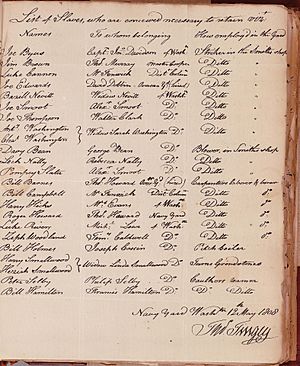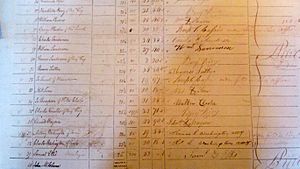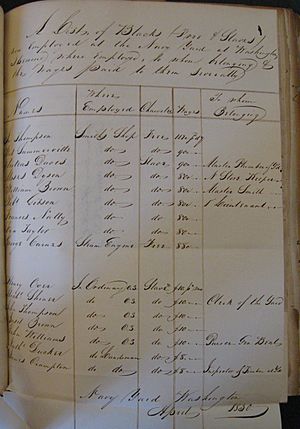Joe Thompson vs Walter Clarke facts for kids
Joe Thompson vs Walter Clarke was a very important court case decided in December 1817. It was about an enslaved man named Joe Thompson who fought for his freedom.
Contents
Joe Thompson's Story
Joe Thompson was born around 1784 in St. Mary's County, Maryland. He was enslaved by a wealthy farmer named John Thompson. When John Thompson died in 1804, his will said that many of his enslaved people, including Joe and his wife Nell, should be freed after 10 years. Younger enslaved people were to be freed after different time periods.
Most enslaved people in the District of Columbia were enslaved for their entire lives. But if a will promised freedom after a certain time, they were called "term slaves."
A Challenge to Freedom
John Thompson's widow, Elizabeth, did not agree with his will. She challenged it, especially the parts about freeing enslaved people. After she died, her brother-in-law, Walter Clarke, took over her estate. Walter Clarke was a successful businessman and also enslaved people himself.
Clarke quickly tried to stop the parts of the will that would free Joe, Nell, and their daughter Sarah Ann. He kept them enslaved even after 1808.
Around 1808, Walter Clarke rented Joe Thompson to the Washington Navy Yard. Joe worked there for many years as a blacksmith striker, which meant he helped the blacksmith.
For the first 30 years of the 1800s, the Navy Yard was the biggest employer of enslaved African Americans in the District. By 1808, enslaved people made up one-third of the workers. The Navy Yard was a common place for owners to rent out their enslaved workers.
Enslaved workers at the Navy Yard were not passive. They often found ways to resist. For example, in 1809, a free Black ship caulker named Henry Adams bravely wrote to the Secretary of the Navy asking for the same pay as white men.
Life as a Blacksmith Striker
The work environment in the blacksmith shop was very tough. In 1811, an architect named Benjamin Latrobe described Joe Thompson's boss, Benjamin King, as "swearing and whipping his black Strikers at a terrible rate." King, who also enslaved people, believed that enslaved workers were better for his shop because they were easier to control.
Joe Thompson and his wife, Nelly, knew about the terms of John Thompson's will. They kept track of the time.
Fighting for Freedom
By 1815, Joe Thompson found Francis Scott Key, a famous lawyer who was known for helping enslaved people and formerly enslaved people, often for free. Key, even though he enslaved people himself, had a reputation for taking on these important cases.
In 1815, Joe Thompson filed a petition for freedom. He was represented by Francis Scott Key and Augustus Taney. The court case, Joe Thompson vs Walter Clarke, was decided in December 1817. The court ruled in favor of Joe Thompson, granting him his freedom!
The Court's Decision
The Circuit Court of the District of Columbia made an important ruling. Judge William Cranch said that if a will states that enslaved people should be freed after a certain time, and the widow of the deceased person gives up her rights to the estate, then the enslaved people should still get their freedom. This is true even if the executor (the person managing the will) had given them to the widow.
Life After Freedom
After winning his freedom, Joe Thompson continued to work at the Washington Navy Yard blacksmith shop. He is listed on payrolls in 1819 and 1829 as a free blacksmith striker. His pay rate was $1.12 per day.
News of Joe Thompson's victory spread quickly among the African American community at the Navy Yard. One of Joe's co-workers, Michael Shiner, was in a similar situation. He was also supposed to be freed after 10 years. In 1836, Shiner, who had worked with Joe Thompson for years, decided to use the same strategy. He filed his own petition for freedom and won!
Impact of the Case
While the Joe Thompson vs Walter Clarke case was a win for Joe, its impact on other cases was somewhat limited. This was because the ruling depended on the specific details of John Thompson's will and how his widow acted.
However, this ruling still made a "significant impression" at the Navy Yard. It gave hope and showed a path to freedom for other enslaved workers and freedom seekers like Michael Shiner and Daniel Bell.




